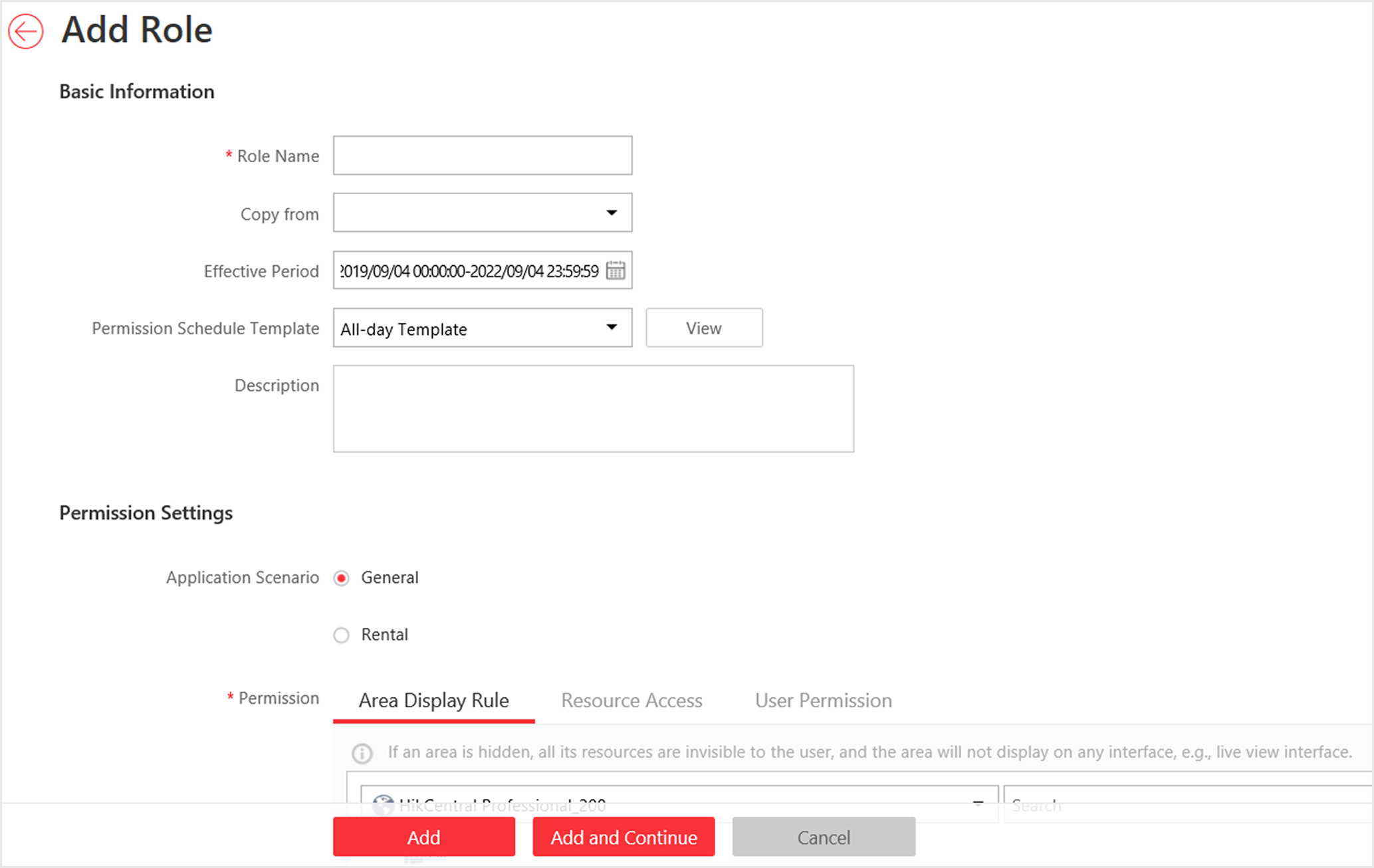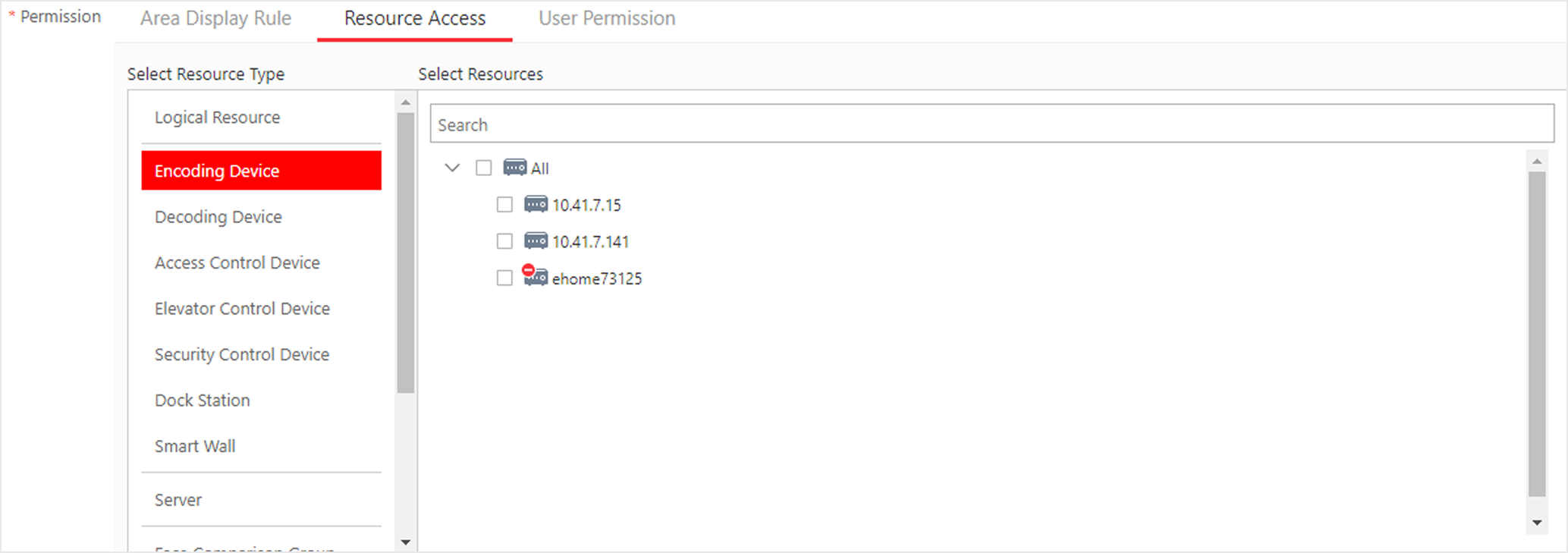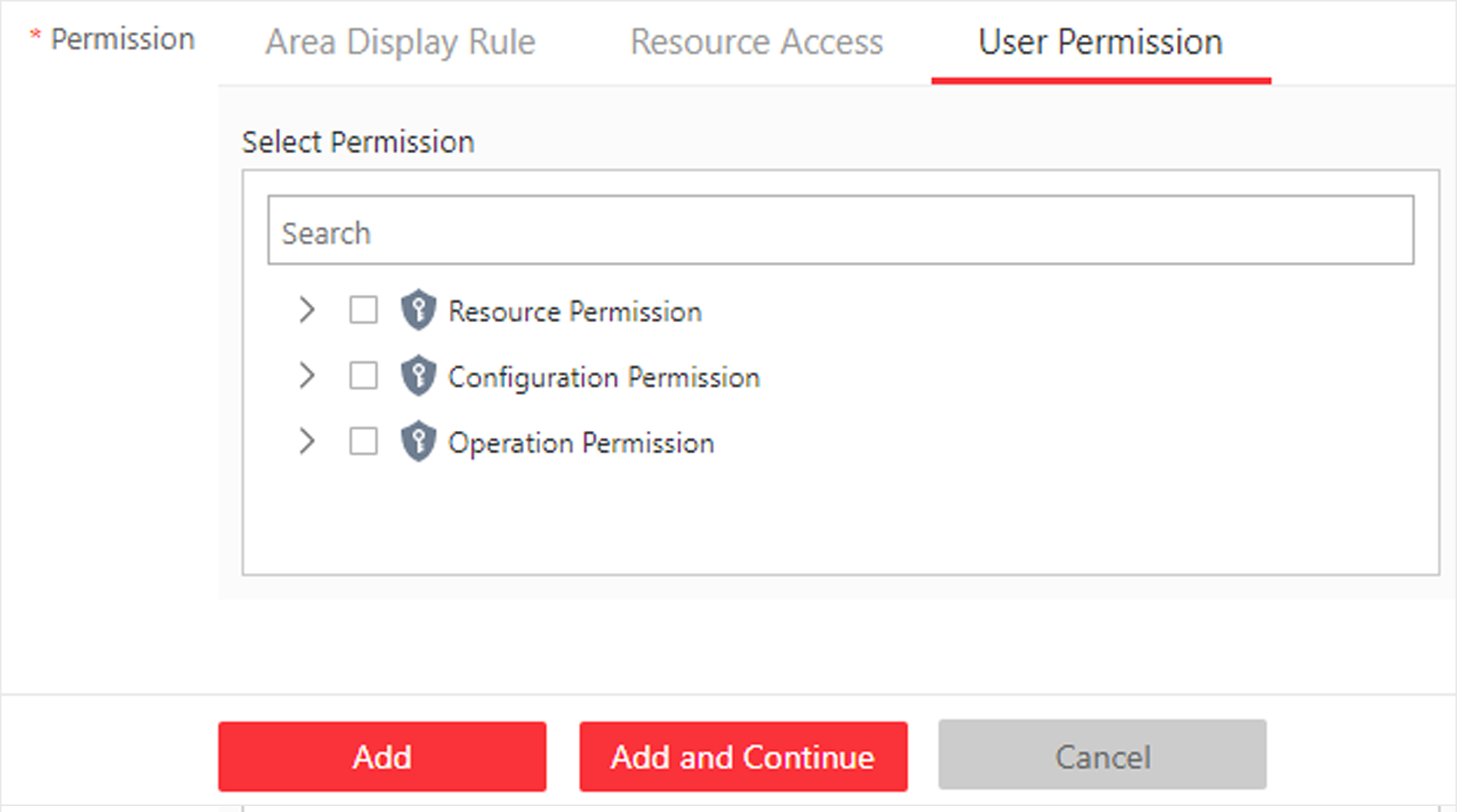Add Role
You can assign permissions to the roles as required, and the users can be assigned with different roles to obtain different permissions.
-
Click Security > Roles to enter the role management page.
Note:
The system pre-defines two default roles: administrator and operator. You can click the role name to view the details and operations. The two default roles cannot be edited or deleted.
-
Click Add to enter the Add Role page.
Figure 1. Add Role Page

-
Set the basic information of the role, including role name, effective period,
permission schedule template, role status, etc.
- Effective Period
-
The date that this role takes effect.
- Permission Schedule Template
-
Set the authorized time period when the role's permission is valid. Select All-day Template/Weekday Template/Weekend Template as the permission schedule of the role, or click Add New to customize a new permission schedule template for the role.
Note:-
The role's permission will expire when the current time is not in the authorized time period of the permission schedule.
-
When the permission expires, the role will be logged out and not be allowed to login.
-
The permission schedule's time zone is consistent with that of the system.
-
If the role's permission is invalid after editing the permission schedule, the role will be forced to exit the system.
-
By default, the role will be linked with All-day Template after updating the system.
-
The permission schedule also goes for RSM client and OpenSdk client.
-
Set the permission for the role.
-
Select the default or pre-defined role from the Copy from drop-down list to copy the permission settings of selected role.
-
Select Application Scenario for the role. If you select General, you need to assign the permissions to the role; if you select Rental, you need to select access groups for the rental so that the role can be verified by the devices of the selected access groups.
Note:For a rental role, only Person module, person list, and access group are available.
- Area Display Rule
-
Show or hide the specific area(s) for the role. If the area is hidden, the user with the role cannot view and access the area and its resources on any interface.
Figure 2. Area Display Rule
- Resource Access Permission
-
Select the functions from the left panel and select resources from right panel to assign the selected resources' permission to the role.
Note:If you do not check the resources, the resource permission cannot be applied to the role.
Figure 3. Resource Access Permission
- User Permission
-
Assign the resource permissions, configuration permissions and operation permissions to the role.
Figure 4. User Permission Note:
Note:In Resource Permission, you can set time restriction for video playback permission. After that, the role's permission of viewing and downloading video playback will be restricted within the configured time period. For example, if you set restricting for recent video for 6 minutes, the role can only view video playback of the camera that he/she has permission to for 6 the recent minutes.
Figure 5. Playback Permission
-
-
Complete adding the role.
-
Click Add to add the role.
-
Click Add and Continue to save the settings and continue to add roles.
-
- Optional:
After adding the role, you can do one or more of the following:
Option Description Edit Role
Click the Name field to edit the settings of the role.
Refresh Role
Click Refresh All to get the latest status of the roles.
Delete Role
Click Delete to delete the role.
Filter Role
Click
 to expand the filter
conditions. Set the conditions and click
Filter to filter the roles according to
the set conditions.
to expand the filter
conditions. Set the conditions and click
Filter to filter the roles according to
the set conditions.
- Legal Information
- Symbol Conventions
- About Web Client
- Login
- Download Mobile Client
- Web Control
- Manage License
- Manage Resource
- Create Password for Inactive Device(s)
- Edit Online Device's Network Information
- Manage Encoding Device
- Add Detected Online Device
- Add Encoding Device by IP Address or Domain Name
- Add Encoding Devices by IP Segment
- Add Encoding Devices by Port Segment
- Add Encoding Device by Hik-Connect DDNS
- Add Encoding Device by Device ID
- Add Encoding Devices by Device ID Segment
- Add Encoding Devices in a Batch
- Limit Bandwidth for Video Downloading
- Set N+1 Hot Spare for NVR
- Network Transmission Device Management
- Upgrade Device Firmware
- Restore/Reset Device Password
- Manage Remote Site
- Manage Application Data Server
- Manage Recording Server
- Manage Streaming Server
- Manage DeepinMind Server
- Add Security Audit Server
- Manage Smart Wall
- Manage Area
- Add Area
- Add Element to Area
- Edit Element in Area
- Edit Camera for Current Site
- Configure Visual Tracking
- Configure Smart Linkage
- Edit Door for Current Site
- Edit Elevator for Current Site
- Edit Radar for Current Site
- Edit Alarm Input for Current Site
- Edit Alarm Output for Current Site
- Edit Under Vehicle Surveillance System for Current Site
- Edit Third-Party Integrated Resource for Current Site
- Edit Element for Remote Site
- Remove Element from Area
- Manage Resource Group
- Configure Recording
- Configure Event and Alarm
- Manage Map
- Manage Person List
- Manage Visitor
- Manage Access Control and Elevator Control
- Flow Chart
- Manage Access Control Device
- Manage Elevator Control Device
- Manage Access Level
- Access Control Test
- Advanced Functions
- Manage Video Intercom
- Flow Chart
- Manage Video Intercom Device
- Batch Link Persons with Indoor Station
- Relate Doorbell with Indoor Station
- Configure Device Parameters
- Manage Time and Attendance
- Flow Chart
- Add Attendance Group
- Add Timetable
- Add Shift Schedule
- Assign Shift Schedule to Attendance Group
- Configure Attendance Parameters
- Manage Attendance Record
- Search Attendance Record
- Correct Attendance Record for Single Person
- Correct Check-In/Out for Multiple Persons
- Apply for Leave for Single Person
- Apply for Leave for Multiple Persons
- Manually Calculate Attendance Results
- Export Attendance Records
- Get Attendance Records from Device
- View Attendance Handling Records
- Configure Attendance Report
- Manage Entrance and Exit
- Manage Facial Comparison
- Dock Station
- Manage Security Control
- Manage Security Control Device
- Add Detected Online Device
- Add Security Control Device by IP Address
- Add Security Control Device by Hik-Connect DDNS
- Add Security Control Devices by IP Segment
- Add Security Control Devices by Port Segment
- Add Security Control Device by Device ID
- Add Security Control Device by Device ID Segment
- Add Security Control Devices in a Batch
- Add Security Control Partitions from Device
- Configure Defense Schedule Template
- Manage Security Control Device
- Manage Role and User
- Maintenance
- Manage System Security
- System Configuration
- Set Site Name
- Set User Preference
- Set Warning Threshold for Server Usage
- Set Printer
- Set NTP
- Set Active Directory
- Enable Receiving Generic Event
- Allow for Remote Site Registration
- Register to Central System
- Device Access Protocol
- Set WAN Access
- Set Network Timeout
- Set Device Access Mode
- Set IP Address for Receiving Device Information
- Set Data Retention Period
- Set Holiday
- Set Email Template
- Send Report Regularly
- Enable Evidence Collection
- Set Transfer Protocol
- Set Camera ID
- Export Service Component Certificate
- Set Database Password
- Set Health Check Frequency
- Add Fuzzy Matching Rules for License Plate Search
- Configure System Hot Spare
- Set Third-Party Integration
- Data Interchange
- Reset Device Network Information
- Set SUP Upgrade Prompt
- Monitoring
- Intelligent Analysis Report
- Skin-surface Temperature
- Important Ports
Add Role
You can assign permissions to the roles as required, and the users can be assigned with different roles to obtain different permissions.
-
Click Security > Roles to enter the role management page.
Note:
The system pre-defines two default roles: administrator and operator. You can click the role name to view the details and operations. The two default roles cannot be edited or deleted.
-
Click Add to enter the Add Role page.
Figure 1. Add Role Page

-
Set the basic information of the role, including role name, effective period,
permission schedule template, role status, etc.
- Effective Period
-
The date that this role takes effect.
- Permission Schedule Template
-
Set the authorized time period when the role's permission is valid. Select All-day Template/Weekday Template/Weekend Template as the permission schedule of the role, or click Add New to customize a new permission schedule template for the role.
Note:-
The role's permission will expire when the current time is not in the authorized time period of the permission schedule.
-
When the permission expires, the role will be logged out and not be allowed to login.
-
The permission schedule's time zone is consistent with that of the system.
-
If the role's permission is invalid after editing the permission schedule, the role will be forced to exit the system.
-
By default, the role will be linked with All-day Template after updating the system.
-
The permission schedule also goes for RSM client and OpenSdk client.
-
Set the permission for the role.
-
Select the default or pre-defined role from the Copy from drop-down list to copy the permission settings of selected role.
-
Select Application Scenario for the role. If you select General, you need to assign the permissions to the role; if you select Rental, you need to select access groups for the rental so that the role can be verified by the devices of the selected access groups.
Note:For a rental role, only Person module, person list, and access group are available.
- Area Display Rule
-
Show or hide the specific area(s) for the role. If the area is hidden, the user with the role cannot view and access the area and its resources on any interface.
Figure 2. Area Display Rule
- Resource Access Permission
-
Select the functions from the left panel and select resources from right panel to assign the selected resources' permission to the role.
Note:If you do not check the resources, the resource permission cannot be applied to the role.
Figure 3. Resource Access Permission
- User Permission
-
Assign the resource permissions, configuration permissions and operation permissions to the role.
Figure 4. User Permission Note:
Note:In Resource Permission, you can set time restriction for video playback permission. After that, the role's permission of viewing and downloading video playback will be restricted within the configured time period. For example, if you set restricting for recent video for 6 minutes, the role can only view video playback of the camera that he/she has permission to for 6 the recent minutes.
Figure 5. Playback Permission
-
-
Complete adding the role.
-
Click Add to add the role.
-
Click Add and Continue to save the settings and continue to add roles.
-
- Optional:
After adding the role, you can do one or more of the following:
Option Description Edit Role
Click the Name field to edit the settings of the role.
Refresh Role
Click Refresh All to get the latest status of the roles.
Delete Role
Click Delete to delete the role.
Filter Role
Click
 to expand the filter
conditions. Set the conditions and click
Filter to filter the roles according to
the set conditions.
to expand the filter
conditions. Set the conditions and click
Filter to filter the roles according to
the set conditions.